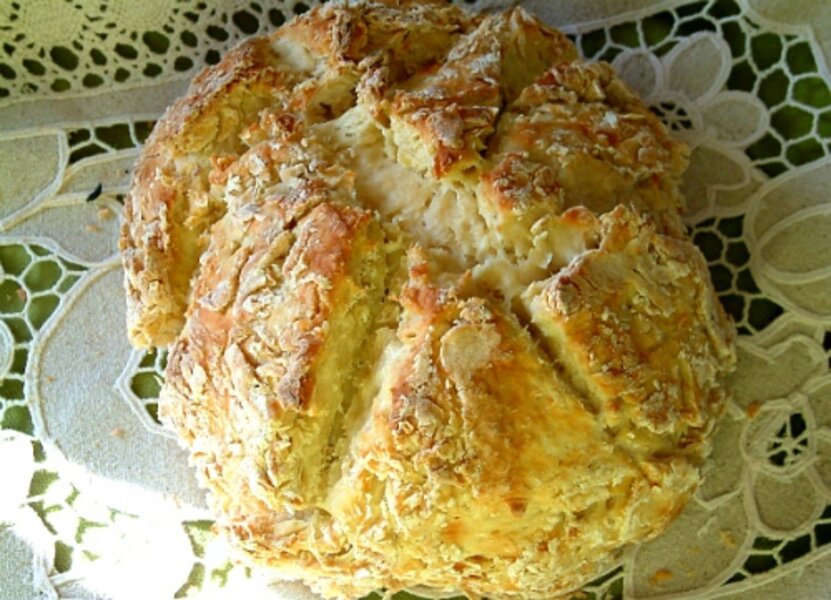Traditional Irish soda bread
Loading...
You might call this a pre St. Patrick’s Day post, except here in Boston I’m a little bit late. St. Patrick’s Day celebrations start the weekend before March 17 because there just simply isn’t enough time to get in all the Irish-related festivities in just a day or two. We may not dye our river green the way Chicago does, but this is still the home of the Boston Celtics. Plus, we are geographically closer to Ireland than Chicago, so I think this qualifies us as more authentically Irish-American than our Midwestern cousins. Somehow.
I’ve only been to the St. Patty’s Day parade in South Boston once, right around the height of Riverdance mania and Southie-based “Good Will Hunting” winning an Oscar. It was fun with lots of kelly green shamrocks fluttering in the breeze, high stepping Irish dancers on flatbeds being towed by trucks, and waving Irish-American politicians. But once was enough, really. I mostly duck and cover on St. Patrick’s Day because the crowds rival those of New Year’s Eve.
Baking traditional Irish soda bread is a quieter, humbler way to celebrate the day. I think St. Patrick, who is said to have used the three-petaled shamrock to explain the Holy Trinity to the pagan Irish, might have approved of the breaking of bread as way to mark his contributions to his countrymen.
Irish soda bread starts to appear in the grocery stores in Boston a couple of weeks prior to the holiday, and these are usually raisin filled and sweet. Traditionalists take great umbrage with this since Irish soda bread was the hearty sustenance of hard working farm families who couldn’t afford things like sugar and dried fruit.
Flour is typically made from soft wheat in Ireland, so using a cake or pastry flour with lower levels of gluten will be the most similar to the flour used by traditionalists, but all-purpose flour works just as well. The Society for the Preservation of Irish Soda bread is very serious about defending tradition, and you can read more about what not to put in your Irish soda bread here.
“Real” Irish soda bread dough is simple, with just four ingredients. If you want to be even more “authentic,” you can bake it in a Dutch iron pot, or an iron skillet, similar to the bastible pot that was set directly on hot coals in place of an oven. The Society for the Preservation of Irish Soda Bread suggests baking the dough in the oven sandwiched between two cake pans. Or you can simply use a baking sheet.
The result is a dense, doughy bread with a crunchy crust and a stick-to-your-ribs interior, a perfect companion to corned beef and cabbage or Irish lamb stew. It’s so simple to bake, you won’t need to rely on the luck o’ the Irish to pull this off. Don’t forget, everyone is Irish on St. Patrick’s Day.
Traditional Irish soda bread
4 cups of all-purpose flour
1 teaspoon baking soda
1 teaspoon sea salt (any salt is fine; sea salt adds an extra crunch)
1-3/4 cups of buttermilk (or 1 tablespoon plus 1/2 teaspoon white vinegar and 1-3/4 cups milk)
If you are going to sour regular milk instead of using buttermilk, start this process first. Add the vinegar to a large measuring cup and then add the milk. Let rest 5-15 minutes.
Preheat oven to 425 degrees F.
Lightly grease and flour a 9-inch cake pan.
Sift together the flour, baking soda, and salt. Stir to combine. Create a well in the center and add the buttermilk or sour milk gradually, stirring until all the flour has been gathered into a sticky dough. If you have extra floury flakes, you may need to add a bit more milk.
Turn the dough onto a lightly floured surface and knead gently, 10 seconds or so (do not overknead or the dough won’t rise as much).
Set the rounded dough into the cake pan. Cut a cross into the top of the dough. Cover with another cake pan or pot of same size. If you don’t have cake pans, you can set the dough on a baking sheet.
Bake for 30 minutes, then remove the upper pan and bake for another 15 minutes until crust is just beginning to turn golden.
The bottom of the baked bread should have a hollow sound when tapped. Cover the warm bread in a tea towel and lightly sprinkle water on the cloth to keep the bread moist.
Serve warm.
Related posts: Proper English Scones, Feijoada (Brazilian black bean stew)







